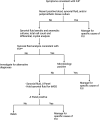Comparison of the BioFire Joint Infection Panel to 16S Ribosomal RNA Gene-Based Targeted Metagenomic Sequencing for Testing Synovial Fluid from Patients with Knee Arthroplasty Failure
- PMID: 36409108
- PMCID: PMC9769560
- DOI: 10.1128/jcm.01126-22
Comparison of the BioFire Joint Infection Panel to 16S Ribosomal RNA Gene-Based Targeted Metagenomic Sequencing for Testing Synovial Fluid from Patients with Knee Arthroplasty Failure
Abstract
The diagnosis of periprosthetic joint infection (PJI) is challenging, often requiring multiple clinical specimens and diagnostic techniques, some with prolonged result turnaround times. Here, the diagnostic performance of the Investigational Use Only (IUO) BioFire Joint Infection (JI) Panel was compared to 16S rRNA gene-based targeted metagenomic sequencing (tMGS) applied to synovial fluid for PJI diagnosis. Sixty synovial fluid samples from knee arthroplasty failure archived at -80°C were tested. Infectious Diseases Society of America (IDSA) diagnostic criteria were used to classify PJI. For culture-positive PJI with pathogens targeted by the JI panel, JI panel sensitivity was 91% (21/23; 95% confidence interval [CI], 73 to 98%), and tMGS sensitivity was 96% (23/24; 95% CI, 80 to 99%) (P = 0.56). Overall sensitivities of the JI panel and tMGS for PJI diagnosis were 56% (24/43; 95% CI, 41 to 70%) and 93% (41/44; 95% CI, 82 to 98%), respectively (P < 0.001). JI panel and tMGS overall specificities were 100% (16/16; 95% CI, 81 to 100%) and 94% (15/16; 95% CI, 72 to 99%), respectively. While the clinical sensitivity of the JI panel was excellent for on-panel microorganisms, overall sensitivity for PJI diagnosis was low due to the absence of Staphylococcus epidermidis, a common causative pathogen of PJI, on the panel. A PJI diagnostic algorithm for the use of both molecular tests is proposed.
Keywords: PCR; next-generation sequencing; periprosthetic joint infection; rapid diagnostic.
Conflict of interest statement
The authors declare a conflict of interest. M.A.A., M.J.W., A.P.S., M.L.D., J.C.S., A.D.D., M.P.A., and K.E.G.-Q. have no conflicts of interests to declare. R.P. reports grants from ContraFect, TenNor Therapeutics Limited, and BioFire. R.P. is a consultant to Curetis, Next Gen Diagnostics, PathoQuest, Selux Diagnostics, 1928 Diagnostics, PhAST, Torus Biosystems, Day Zero Diagnostics, Mammoth Biosciences, and Qvella; monies are paid to Mayo Clinic. Mayo Clinic and R.P. have a relationship with Pathogenomix. R.P. has research supported by Adaptive Phage Therapeutics. Mayo Clinic has a royalty-bearing know-how agreement and equity in Adaptive Phage Therapeutics. R.P. is also a consultant to Netflix and CARB-X. In addition, R.P. has a patent on
Figures

Similar articles
-
Clinical Use of a 16S Ribosomal RNA Gene-Based Sanger and/or Next Generation Sequencing Assay to Test Preoperative Synovial Fluid for Periprosthetic Joint Infection Diagnosis.mBio. 2022 Dec 20;13(6):e0132222. doi: 10.1128/mbio.01322-22. Epub 2022 Nov 10. mBio. 2022. PMID: 36354331 Free PMC article.
-
Targeted Versus Shotgun Metagenomic Sequencing-based Detection of Microorganisms in Sonicate Fluid for Periprosthetic Joint Infection Diagnosis.Clin Infect Dis. 2023 Feb 8;76(3):e1456-e1462. doi: 10.1093/cid/ciac646. Clin Infect Dis. 2023. PMID: 35944127 Free PMC article.
-
The 2018 Definition of Periprosthetic Hip and Knee Infection: An Evidence-Based and Validated Criteria.J Arthroplasty. 2018 May;33(5):1309-1314.e2. doi: 10.1016/j.arth.2018.02.078. Epub 2018 Feb 26. J Arthroplasty. 2018. PMID: 29551303
-
Diagnosis of Periprosthetic Joint Infection-An Algorithm-Based Approach.J Arthroplasty. 2017 Jul;32(7):2047-2050. doi: 10.1016/j.arth.2017.02.070. Epub 2017 Mar 2. J Arthroplasty. 2017. PMID: 28343826 Review.
-
Diagnostic Accuracy of Serum, Synovial, and Tissue Testing for Chronic Periprosthetic Joint Infection After Hip and Knee Replacements: A Systematic Review.J Bone Joint Surg Am. 2019 Apr 3;101(7):635-649. doi: 10.2106/JBJS.18.00632. J Bone Joint Surg Am. 2019. PMID: 30946198
Cited by
-
Pathogen detection by targeted next-generation sequencing test in adult hematological malignancies patients with suspected infections.Front Med (Lausanne). 2024 Sep 24;11:1443596. doi: 10.3389/fmed.2024.1443596. eCollection 2024. Front Med (Lausanne). 2024. PMID: 39380735 Free PMC article.
-
Clinically applicable optimized periprosthetic joint infection diagnosis via AI based pathology.NPJ Digit Med. 2024 Oct 26;7(1):303. doi: 10.1038/s41746-024-01301-7. NPJ Digit Med. 2024. PMID: 39462052 Free PMC article.
-
Application of a metatranscriptomics technology, CSI-Dx, for the detection of pathogens associated with prosthetic joint infections.Sci Rep. 2024 Oct 23;14(1):25100. doi: 10.1038/s41598-024-74375-8. Sci Rep. 2024. PMID: 39443495 Free PMC article.
-
Practical Guidance for Clinical Microbiology Laboratories: Microbiologic diagnosis of implant-associated infections.Clin Microbiol Rev. 2024 Jun 13;37(2):e0010423. doi: 10.1128/cmr.00104-23. Epub 2024 Mar 20. Clin Microbiol Rev. 2024. PMID: 38506553 Free PMC article. Review.
-
16S Ribosomal RNA Gene PCR and Sequencing for Pediatric Infection Diagnosis, United States, 2020-2023.Emerg Infect Dis. 2025 May;31(13):129-136. doi: 10.3201/eid3113.241101. Emerg Infect Dis. 2025. PMID: 40359099 Free PMC article.
References
-
- Atkins BL, Athanasou N, Deeks JJ, Crook DW, Simpson H, Peto TE, McLardy-Smith P, Berendt AR, The OSIRIS Collaborative Study Group . 1998. Prospective evaluation of criteria for microbiological diagnosis of prosthetic joint infection at revision arthroplasty. J Clin Microbiol 36:2932–2939. doi:10.1128/JCM.36.10.2932-2939.1998. - DOI - PMC - PubMed
MeSH terms
Substances
LinkOut - more resources
Full Text Sources
Medical

